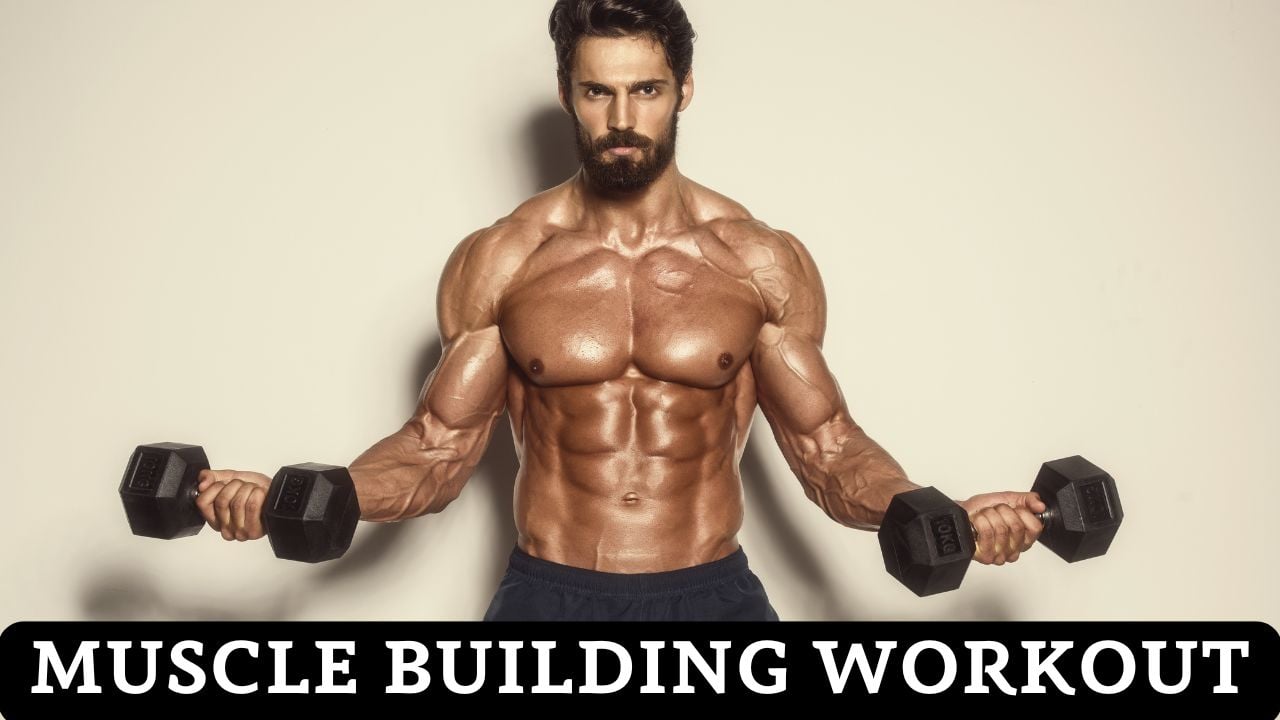MUSCLE BUILDING WORKOUT
Create your personalized muscle building workout program with our AI-powered planner. Get tailored routines that match your goals, experience level, and equipment preferences.

BASIC WORKOUT INFORMATION
Training Focus
Available Equipment
Health & Limitations
Science-Based Muscle Building Workout Program
This comprehensive muscle building program is designed based on cutting-edge scientific research and evidence-based training principles. Building muscle effectively requires more than just lifting weights—it demands:
- Strategic planning of workout frequency and volume
- Proper exercise selection for maximum muscle recruitment
- Intelligent progression strategies to continuously challenge your muscles
- Adequate nutrition and recovery to support growth
Whether you’re looking to increase strength, boost athletic performance, or enhance physique development, this program incorporates the most effective research-backed approaches to stimulate maximum hypertrophy across all major muscle groups.
Research-Backed Muscle Building Evidence
Optimal Training Volume & Frequency
A landmark meta-analysis published in PubMed (Schoenfeld et al.) examined the relationship between training volume and muscle hypertrophy.
The research conclusively demonstrated that higher weekly training volumes (10+ sets per muscle group) produced superior hypertrophic outcomes compared to lower volumes.
Key findings include:
- Training each muscle group 2-3 times per week with moderate volume per session was more effective than training each muscle once per week with high volume
- More frequent training sessions lead to more protein synthesis stimulation
- Better recovery patterns between workouts
- Enhanced neural adaptations from repeated exposure
Training Intensity & Rep Ranges
Research published in The International Journal of Exercise Science investigated hypertrophic responses across different loading ranges.
The findings revealed that muscle growth can occur across multiple repetition ranges when sets are performed near failure:
- Heavy loads (1-5 reps, >85% 1RM): Maximize mechanical tension and neural adaptations
- Moderate loads (8-12 reps, 70-80% 1RM): Optimal balance of tension and metabolic stress
- Lighter loads (15-30 reps, 30-65% 1RM): Emphasize metabolic stress and endurance adaptations
This “repetition continuum” approach suggests that incorporating varied rep ranges may optimize growth by targeting different muscle fiber types and metabolic pathways.
Exercise Selection & Movement Patterns
A comprehensive review published in Research Gate analyzed the effectiveness of different exercises for muscle development.
The analysis found that compound, multi-joint movements (such as those listed in Fit Life Regime’s barbell exercises guide) should form the foundation of any muscle-building program due to their ability to:
- Recruit large amounts of muscle mass simultaneously
- Stimulate greater hormonal responses (testosterone, growth hormone)
- Allow for progressive overload with heavier weights
- Train movement patterns that transfer to real-world activities
However, research also indicates that supplementing compound movements with targeted isolation exercises can maximize development of specific muscle groups, particularly smaller muscles or those with biomechanical disadvantages in compound lifts.
Essential Muscle Building Training Principles
Progressive Overload
Progressive overload is the foundation of all muscle growth. Your muscles adapt to the stress placed upon them—to continue growing, you must continually increase this stress over time.
Effective methods to implement progressive overload include:
- Increasing weight (adding more resistance)
- Increasing repetitions (with the same weight)
- Increasing sets (additional volume)
- Decreasing rest periods (intensifying workload)
- Improving execution (better mind-muscle connection)
For optimal results, focus on gradually increasing weight while maintaining proper form, then adding repetitions before increasing weight again.
Proper Exercise Selection
Your workout program should be built around compound exercises that engage multiple muscle groups simultaneously, providing the greatest stimulus for growth.
A balanced muscle-building program should include:
- Pushing movements: Bench press, overhead press, push-ups, dips
- Pulling movements: Rows, pull-ups, pulldowns
- Squat pattern: Back squats, front squats, leg press
- Hinge pattern: Deadlifts, hip thrusts, Romanian deadlifts
- Isolation work: Targeted exercises for specific muscles
This balanced approach ensures comprehensive development and minimizes muscular imbalances that can lead to injury.
Training Volume & Frequency
Training volume (sets × reps × weight) is a critical factor in muscle hypertrophy. Research indicates that higher volumes generally produce greater muscle growth, up to a point of diminishing returns.
For optimal muscle development:
- Aim for 10-20 sets per muscle group per week
- Train each muscle group 2-3 times per week
- Begin with the lower end of volume recommendations if you’re a beginner
- Gradually increase volume as your recovery capacity improves
- Monitor for signs of overtraining (decreased performance, prolonged soreness)
Distributing volume across multiple weekly sessions rather than single high-volume workouts typically produces better results.
Rest & Recovery
Muscle growth occurs during recovery periods, not during the workout itself. Inadequate recovery leads to diminished returns and increased injury risk.
Key recovery strategies include:
- Allow 48-72 hours between training sessions for the same muscle group
- Prioritize 7-9 hours of quality sleep each night
- Maintain proper hydration and nutrition (adequate protein and calories)
- Incorporate active recovery sessions (light cardio, mobility work)
- Consider deload weeks every 4-8 weeks to prevent overtraining
Remember: Your results are determined by how well you recover, not just by how hard you train.
Key Muscle Building Exercises
Barbell Bench Press
The barbell bench press is widely recognized as the premier exercise for chest development. EMG studies show it effectively activates the pectoralis major, anterior deltoids, and triceps. Research indicates that the flat bench press variation maximizes overall pectoral activation, while incline variations preferentially target the upper chest fibers. For optimal development, its recommends using a moderate grip width (1.5× shoulder width) and bringing the bar to the mid-chest region to maximize pectoral engagement while minimizing shoulder strain. Progressive loading on this exercise correlates strongly with overall upper body strength and mass development.
Barbell Back Squat
The barbell back squat serves as the foundation for lower body mass development. Biomechanical analysis shows it activates over 200 muscles throughout the body with primary emphasis on the quadriceps, gluteals, and core musculature. Squats performed to proper depth (hip crease below parallel) not only maximize muscle activation but also stimulate significant anabolic hormone release, creating a favorable environment for total-body muscle growth.
Barbell Deadlift
The conventional deadlift is unparalleled for developing total posterior chain mass. Research shows deadlifts simultaneously target the erector spinae, glutes, hamstrings, trapezius, and forearms, making it one of the most efficient exercises for total muscle recruitment. Studies cited in PubMed demonstrate that deadlifts elicit significant increases in anabolic hormones like testosterone and growth hormone, creating a systemic environment conducive to overall muscle growth. The exercise’s comprehensive nature makes it particularly effective for building “functional” muscle mass that transfers to real-world strength and performance.
Pull-Ups & Chin-Ups
Pull-ups and chin-ups represent premier upper back and biceps developers. EMG analysis shows the wide-grip pull-up maximizes latissimus dorsi activation, while the supinated grip chin-up increases biceps brachii involvement. These exercises activate multiple upper back muscles simultaneously (including the latissimus dorsi, trapezius, rhomboids, and posterior deltoids) more effectively than many machine-based alternatives. Progressive overload with these bodyweight exercises—through added external weight or increased repetitions—effectively triggers hypertrophic adaptations in the entire upper back musculature.
Overhead Press
The standing barbell overhead press stands as a foundational exercise for shoulder development. It effectively activates all three deltoid heads (anterior, medial, and posterior) while engaging the trapezius, triceps, and core musculature. The press also requires significant stabilization throughout the movement, enhancing overall neuromuscular coordination. Studies show that heavy overhead pressing correlates strongly with increased deltoid hypertrophy and contributes to improved shoulder stability. The exercise’s multijoint nature makes it particularly valuable for stimulating anabolic hormone release while developing functional strength through the shoulders and upper body.
Barbell Row
The bent-over barbell row is a cornerstone movement for back thickness and width development. Biomechanical It effectively targets the latissimus dorsi, trapezius, rhomboids, rear deltoids, and biceps. Rowing movements develop back thickness and muscular density that complement the width-focused adaptations from vertical pulling exercises like pull-ups. Maintaining a neutral spine position with slight torso angle (around 45 degrees) optimizes muscle activation while minimizing lower back stress. The exercise’s versatility allows for grip and angle modifications to target different aspects of the back musculature.
4-Day Upper/Lower Split Workout Program
This science-backed program focuses on training each muscle group twice per week, providing optimal frequency for strength and hypertrophy while allowing adequate recovery. The upper/lower split is ideal for intermediate lifters looking to build muscle and strength efficiently.
Day 1: Upper Body (Strength Focus)
| Exercise | Sets | Reps | Rest | Notes |
|---|---|---|---|---|
| Barbell Bench Press | 4 | 4-6 | 2-3 min | Focus on progressive overload, adding weight when all sets can be completed |
| Weighted Pull-ups | 4 | 4-6 | 2-3 min | Use assisted version if needed, aim for full range of motion |
| Overhead Press | 3 | 6-8 | 2 min | Keep core tight, avoid excessive arching |
| Barbell Row | 3 | 6-8 | 2 min | Maintain neutral spine, focus on pulling with back muscles |
| Weighted Dips | 3 | 6-8 | 2 min | Use assisted version if needed, focus on chest and triceps |
| Face Pulls | 3 | 10-12 | 1.5 min | Prioritize proper form over weight, focus on rear delts and upper back |
Day 2: Lower Body (Strength Focus)
| Exercise | Sets | Reps | Rest | Notes |
|---|---|---|---|---|
| Barbell Back Squat | 4 | 4-6 | 2-3 min | Focus on depth and maintaining proper form throughout |
| Romanian Deadlift | 4 | 6-8 | 2-3 min | Focus on hamstring stretch, maintain neutral spine |
| Bulgarian Split Squat | 3 | 8-10 (each leg) | 2 min | Focus on stability and control, progress weight gradually |
| Leg Press | 3 | 8-10 | 2 min | Vary foot position to emphasize different muscles |
| Standing Calf Raises | 4 | 12-15 | 1.5 min | Full range of motion, pause at top and bottom |
| Weighted Planks | 3 | 30-60 sec | 1.5 min | Keep body straight, brace core throughout |
Day 3: Rest or Active Recovery
Take a complete rest day or engage in light activities like walking, mobility work, or yoga. This recovery day is crucial for muscle repair and growth.
Day 4: Upper Body (Hypertrophy Focus)
| Exercise | Sets | Reps | Rest | Notes |
|---|---|---|---|---|
| Incline Dumbbell Press | 4 | 8-10 | 1.5-2 min | Focus on controlled eccentric (lowering) phase |
| Chest-Supported Row | 4 | 8-10 | 1.5-2 min | Squeeze shoulder blades together at top of movement |
| Lateral Raises | 3 | 12-15 | 1 min | Focus on controlled movement rather than heavy weight |
| Cable Pullover | 3 | 10-12 | 1.5 min | Focus on lat engagement, keep slight bend in elbows |
| EZ Bar Curl | 3 | 10-12 | 1.5 min | Avoid using momentum, full range of motion |
| Rope Pushdown | 3 | 10-12 | 1.5 min | Keep elbows tucked, fully extend arms at bottom |
Day 5: Lower Body (Hypertrophy Focus)
| Exercise | Sets | Reps | Rest | Notes |
|---|---|---|---|---|
| Barbell Hip Thrust | 4 | 8-10 | 1.5-2 min | Focus on glute contraction at top of movement |
| Hack Squat | 4 | 8-10 | 1.5-2 min | Control the descent, focus on quad engagement |
| Walking Lunges | 3 | 10-12 (each leg) | 1.5 min | Take longer strides to increase hamstring activation |
| Leg Curl | 3 | 10-12 | 1.5 min | Focus on controlled movement and hamstring contraction |
| Seated Calf Raise | 4 | 15-20 | 1 min | Full range of motion, emphasis on stretch at bottom |
| Cable Woodchoppers | 3 | 12-15 (each side) | 1 min | Rotate through hips and core, maintain stable shoulder position |
Days 6-7: Rest or Light Activity
Take these days to rest completely or engage in light recovery activities such as walking, swimming, or mobility work. Prioritize sleep and nutrition to maximize recovery.
Program Implementation Notes
- Progression: Aim to increase weight by 2.5-5% or add 1-2 reps when you can complete all prescribed sets and reps with proper form.
- Warm-up: Begin each workout with 5-10 minutes of light cardio followed by dynamic stretching and lighter warm-up sets of your first 1-2 exercises.
- Form: Prioritize proper technique over lifting heavier weights. If form breaks down, reduce the weight.
- Tracking: Keep a workout log to monitor progress in weights, sets, and reps to ensure progressive overload.
- Deload: Take a deload week every 6-8 weeks by reducing volume (sets and reps) by approximately 40-50% while maintaining intensity (weight).
Related
- Workout Plans for Men
- Badminton Calories Burned Calculator
- Boxing Calories Burned Calculator
- Plank Calories Burned Calculator
- Burpee Calories Burned Calculator
- Crunches Calories Burned Calculator
- Sit-Up Calories Burned
- Zumba Calories Burned Calculator
- Pull Up Calories Burned Calculator
- Push-Up Calories Burned Calculator
- Home Activities Calories Burned Calculator
- Exercise Calories Burned Calculator
- Running Calorie Calculator
- Walking Calorie Burned Calculator
References
- Krzysztofik, M., Wilk, M., Wojdała, G., & Gołaś, A. (2019). Maximizing Muscle Hypertrophy: A Systematic Review of Advanced Resistance Training Techniques and Methods. International Journal of Environmental Research and Public Health, 16(24), 4897. https://doi.org/10.3390/ijerph16244897
- Schoenfeld, B. J., Grgic, J., Van Every, D. W., & Plotkin, D. L. (2021). Loading Recommendations for Muscle Strength, Hypertrophy, and Local Endurance: A Re-Examination of the Repetition Continuum. Sports, 9(2), 32. https://doi.org/10.3390/sports9020032
- Bennie, J. A., & De Cocker, K. (2020). Muscle-strengthening Exercise Epidemiology: A New Frontier in Chronic Disease Prevention. Sports Medicine – Open, 6(1), 1-8. https://doi.org/10.1186/s40798-020-00271-w
- Androulakis Korakakis, P.; Wolf, M.; Coleman, M.; Burke, R.; Piñero, A.; Nippard, J.; Schoenfeld, B.J. Optimizing Resistance Training Technique to Maximize Muscle Hypertrophy: A Narrative Review. J. Funct. Morphol. Kinesiol. 2024, 9, 9.

Manish is a NASM-certified fitness and nutrition coach with over 10 years of experience in weight lifting and fat loss fitness coaching. He specializes in gym-based training and has a lot of knowledge about exercise, lifting technique, biomechanics, and more.
Through “Fit Life Regime,” he generously shares the insights he’s gained over a decade in the field. His goal is to equip others with the knowledge to start their own fitness journey.
